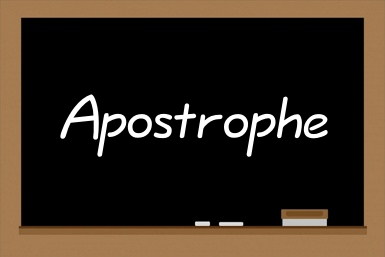The Apostrophe

In this lesson, you'll learn how to correctly use the apostrophe in the English language.
Introduction
There are two uses of the Apostrophe in the English language:
- To show that a word has been shortened
- To show the possessive case of a noun.
This lesson will go over both of these uses.
Contractions
In spoken English words are sometimes not fully pronounced. A word that has been shortened like this is called a contraction. An apostrophe is used in the written language to show that a word has been shortened.
In some very common cases when a word is not fully pronounced, it also loses its stress, so it sounds like it has been joined onto the previous word. The verb "be" is is very often contracted and joined to the subject of the sentence. The following table shows some common contractions of the verb "be":
| Complete Words | Contraction |
|---|---|
| I am | I'm |
| she is | she's |
| he is | he's |
| it is | it's |
| who is | who's |
| we are | we're |
| you are | you're |
| they are | they're |
| John is | John's |
| the cat is | the cat's |
The following table shows some common contractions with other verbs:
| Complete Words | Contraction |
|---|---|
| I will | I'll |
| that will | that'll |
| will not | won't |
| would have | would've |
| would not | wouldn't |
| shall not | shan't |
| should have | should've |
| do not | don't |
| did not | didn't |
| he has | he's |
| have not | haven't |
| she had | she'd |
| had not | hadn't |
| cannot | can't |
| could have | could've |
| could not | couldn't |
| might have | might've |
| must have | must've |
Note:
- "He's" can mean "he is" or "he has".
- Some contractions are irregular such as "won't" for "will not."
- "They're is a contraction of they are, "their" is the possesive form of they, and "there" is an adverb meaning at that place. Be careful with these three words since they all sound the same, so it can be easy to mix them up.
When writing formal documents, it is best to minimize the use of contractions.
Possessive Case of Nouns
The second use for the apostrophe in English is to indicate the possessive case of a noun. When a noun is in the possessive case, it indicates that the noun owns or created the following noun. Pronouns also have a possessive case, but an apostrophe is not used with pronouns to indicate the possessive case. This causes confusion for many people . "It's" is a contraction for "it is" or "it has". "its" is the possesive form of the pronoun "it".
Nouns in the possessive case add an 's to the end of a singular noun. For plural nouns that end in s, an apostrophe is added to the end of the word. For plural nouns that don’t end in s, such as children and people, 's is added to the end of the word.
Examples:
The car’s wheels have been removed.
Mary’s necklace is expensive.
The children’s presents need to be bought.
The cats’ owners are on vacation, so I have to look after them.
Anuncio

